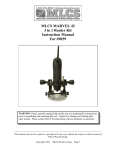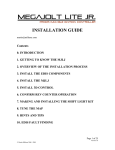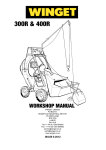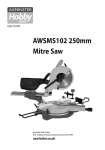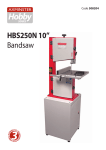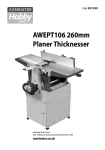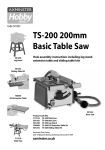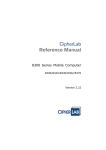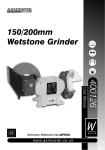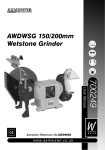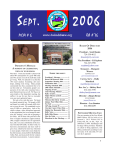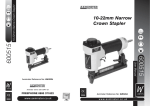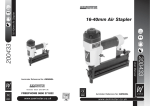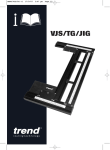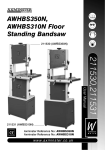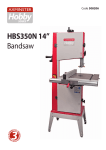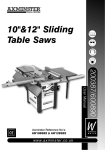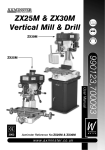Download Axminster AWMS10 User manual
Transcript
250mm Variable Speed Compound Mitre Saw Axminster Reference No: AWMS10 w w w. a x m i n s t e r. c o . u k 108004 User Manual 2005 W AXMINSTER W H I T E Index of Contents... Page No. Index of Contents................................................................................................................... 02 Declaration of Conformity………….………........……..…………........................................03 What’s in the Box………….………........……..…………..........................................................04 General Instructions for 230v Machines................................................. 05-06-07-08 Initial Setup.........................................................................................................08-09 Specifications….………........……..…………........................................................................10 Identification & Description of the Mitre Saw........................................... 10-12-14-15 Illustration and Parts Description ......................................................................11-13-15 Setting Up the Machine................................................................................ 16-17-18 Setting the Laser.................................................................................................19-20 Table of Capacities..................................................................................................21 Changing the Saw Blade................................................................................... 22-23 Illustrated Parts Breakdown for the Mitre Saw.......................................................24 Maintenance.............................................................................................................25 Notes...................................................................................................................26-27 Saf sp irator Re Sa Two E R Ey y Helm fet Safety Protection Symbols r fety Viso Sa et st Mask Du F ootw ety r ea tiv e Glo tec s ve Def ende rs ar bly m n Asse Ma ro tectio eP n AXMINSTER W H I T E al W d Manu ea Pro ! The symbols shown on the cover of this manual advise that you wear the correct safety protection when using this machine. SAFETY!! Declaration of Conformity... W AXMINSTER W H I T E Copied from CE Certificate The undersigned, K. Bodenstein authorised by Zhangjiagang MFG Co., Ltd. No. 8 Haifeng Road, Nan Feng Town Zhangjiagang, Jiangsu 215628 P.R. China declares that this product: MIS-250E-2 Mitre Saw manufactured by Zhangjiagang MFG Co. is in compliance with the following standards or standardisation documents in accordance with Council Directives EN 50366: 2003 FREEPHONE 0800 371822 03 W What’s in the Box... AXMINSTER W H I T E Model Number: MIS 250E-2 1 No. 250mm Variable Speed Compound Mitre Saw 1 No. Clamping Bolt Handle for Turn Table 1 No. Packet containing:1 No. 13mm A/F Box Spanner for the Arbor bolt 1 No. Nippled 'Y' Wrench for Saw Plate Washer 1 No. 5mm Allen Key 1 No. 6mm Allen Key 2 No. AAA Batteries for Laser 1 No. Saw Dust Collection Bag 2 No. Work Piece Clamps 1 No. Instruction Manual 1 No. Guarantee Card Please read the Instruction Manual prior to using your new tool; as well as the operating procedures for your new tool, there are numerous hints and tips to help you to use the tool safely and to maintain its efficiency and prolong its life. There is also a detailed description of the parts of your saw, which will enable you to become familiar with terminology we will use in this manual. Keep this Instruction Manual readily accessible for any others who may also be required to use the tool. 04 www.axminster.co.uk General Instructions for 230v Machines... W AXMINSTER W H I T E Good Working Practices/Safety The following suggestions will enable you to observe good working practices, keep yourself and fellow workers safe and maintain your tools and equipment in good working order. ! WARNING!! KEEP TOOLS AND EQUIPMENT OUT OF THE REACH OF YOUNG CHILDREN General Advice If you are totally unfamiliar with the use of a power saw, please seek at least a minimum of tuition and advice from an informed, qualified source. An amateur woodworker or hobbyist just starting out is advised to undertake a short course on the use of woodworking machines run by a professional woodworker. These are often offered by your local authority, as evening classes., etc. Mains Powered Tools Primary Precautions These tools are double insulated and supplied with a 13 Amp. Plug and 2 core power cable. Before using the tool inspect the cable and the plug to make sure that neither are damaged. If any damage is visible have the tool inspected/repaired by a suitably qualified person. If it is necessary to replace the plug, it is preferable to use an 'unbreakable' type that will resist damage on site. Only use a 13 Amp plug, make sure the cable clamp is tightened securely. Fuse at 13 Amp. It is also recommended that a switched power outlet is used. If extension leads are to be used, carry out the same safety checks on them, and ensure that they are correctly rated to safely supply the current that is required for your machine. Work Place/Environment Always carry the machine with the saw locked in the housed (down) position. Pre-mounting the saw on a sub frame (a suitable piece of plywood/blockboard) with sufficient margin to allow the whole to be clamped onto a stable work surface, increases the speed with which the saw can be brought into operation. However the saw is mounted, make sure that it is clamped/screwed down to a stable, flat surface before commencing operations. The machine is designed for indoor use, do not use when or where it is liable to get wet. If the machine is set up in the open, and it starts to rain (unusual though this would be in U.K.), cover it up or move to a dry place. If the machine has gotten wet; dry it off as soon as possible, with a cloth or paper towel. Do not use 230Va.c. powered machines anywhere within the site area that is flooded or puddled, and do not trail extension cables across wet areas. Keep the machine clean; it will enable you to more easily see any damage that may have occurred. Clean the painted areas of the machine with a damp soapy cloth if needs be, do not use any solvents or cleaners, as these may cause damage to any plastic parts or to the electrical components. Make certain that you have fitted the correct saw blade for the job in hand. Keep the work area as uncluttered as is practical, this includes personnel as well as material. FREEPHONE 0800 371822 05 W General Instructions for 230v Machines... AXMINSTER W H I T E ! WARNING!! UNDER NO CIRCUMSTANCES SHOULD CHILDREN BE ALLOWED IN WORK AREAS Once the saw is mounted, carry out any setting operations, (mitre, tilt..?), and remove all tools used in the setting operations (if any) and place safely out of the way. If you are using long lengths of material arrange for extra support beyond the boundary of the machine. It is good practice to leave the machine unplugged until work is about to commence, also make sure to unplug the machine when it is not in use. Always disconnect by pulling on the plug body and not the cable. DO NOT use your hands to hold the work on the machine, use the clamps provided, and observe the old woodworkers adage of 'never putting your hands closer than one handbreadth to the cutting tool'. Do not attempt to cut or re-cut short pieces that cannot be held by the clamp. Make sure you are comfortable before you start work, balanced, not reaching etc. If the work you are carrying out is liable to generate flying grit, dust or chips, wear the appropriate safety clothing, goggles, gloves, masks etc., If the work operation appears to be excessively noisy, wear ear-defenders. If you wear your hair in a long style, wearing a cap, safety helmet, hairnet, even a sweatband, will minimise the possibility of your hair being caught up in the rotating parts of the tool, likewise, consideration should be given to the removal of rings and wristwatches, if these are liable to be a 'snag' hazard. DO NOT work with cutting tools of any description if you are tired, your attention is wandering or you are being subjected to distraction. A deep cut, a lost fingertip or worse, is not worth it! DO NOT work with cutting tools if you are taking prescribed medicine, unless you have confirmed that this medicine will not impair your awareness or your reactions. DO NOT use the machines within the designated safety areas of flammable liquid stores or in areas where there may be volatile gases. There are very expensive, very specialised machines for working in these areas, THIS IS NOT ONE OF THEM. CHECK that saw blades are undamaged and are kept clean and sharp, this will maintain their operating performance and lessen the loading on the tool. Above all, OBSERVE…. make sure you know what is happening around you, and USE YOUR COMMON SENSE; for no matter how many precautions we list, remember your safety is ultimately your responsibility. General Safety Precautions for Compound Mitre Saw Before using the saw read the instructions thoroughly and make sure you understand them. Carry out a visual inspection of the saw, checking for damage, or anything untoward, (Do you know who used it last? That person may be able to confirm that the saw was “fine” when last used or not, blades need sharpening/replacing etc. 06 www.axminster.co.uk General Instructions for 230v Machines... W AXMINSTER W H I T E General Safety Precautions for Compound Mitre Saw (Continued) DO NOT change blades with power connected. Always use the correct accessories; especially the correctly sized spanner on the arbor bolt, DO NOT risk damaging the saw by using incorrectly fitting accessories. If the saw does not have a specific device to lock the saw shaft, DO NOT jam/wedge the motor fan, it is better to wedge the saw blade with a piece of scrap timber. After fitting the blade, make sure that all ancillary tools used during the blade change operation have been stowed away correctly. REMEMBER THE ARBOR BOLT HAS A LEFT HAND THREAD. When fitting blades, refer to the manufacturer’s instructions concerning the maximum capabilities of the saw, i.e. cutting capacities and capabilities in various materials, observance of these guidelines, and clean, sharp saw blades ensure maximum performance and optimise the life of your saw. DO NOT overload the saw. (Try to cut too fast) CHECK that the blade is fitted correctly, i.e. check that the blade is seated properly, the arbor bolt is fastened and a manual rotation of the blade does not indicate any wobble. CHECK that the kerf slot in the saw gullet (and under) is clear. The kerf slot is fully enclosed, as a safety measure, to protect against the saw teeth protruding through table. REMEMBER to clean it regularly. If the saw gullet gets damaged it may not support the work close up to the blade and this will result in bad breakout. Replace the saw gullet as soon as possible. CHECK the basic parameters of the saw, viz:- check the blade is vertical to the turn table when the tilt indicator reads '0'; check the blade is perpendicular to the rear fence when the turn indicator reads '0'. This will give you confidence that the angles you wish to set on the saw will be correct. If either of these basic parameters is not met, refer to the specific section in the Instruction Manual that deals with “Setting up your machine”. Set the required mitre angle or tilt angle or both, then carry out a “dry” run to ensure that you will be able to complete the saw cut without any problems. Connect the power, give the machine a quick “burst” off load and in a safe position to check that everything is correct before proceeding with the work operation. Make sure that the stuff is hard against the backfence before starting the saw. Always allow the saw to run up to speed before attempting to cut. Pull the saw over in a smooth continuous movement. We strongly advise that all material is clamped to the table before any sawing is carried out. When 'fine' cutting e.g. beads, architraves, framing, etc., if the material is still 'breaking out' at the rear of the cut, you may be able to minimise the damage by the addition of a thin facing board of an appropriate hardwood, clamped or screwed across the face of the fence to act as a “spelch”.(Make sure you fasten the board on both sides of the fence and cut the saw slot before any actual work is done.) FREEPHONE 0800 371822 07 W AXMINSTER W H I T E General Instructions for 230v Machines... General Safety Precautions for Compound Mitre Saw (Continued) When you have finished the cut, allow the saw to rise to its 'up' position, check that the lower guard has returned to cover the saw blade. Allow the blade to come to a stop before removing the workpiece. When working with timber than is bent, bowed, in wind, cupped, etc., make sure that the offending timber is placed to the machine such that the cut will not allow the timber to 'fall' to the table or fence and pinch the saw blade. DO NOT allow the saw to 'stall'; if unfortunate circumstances cause the machine to stall, switch off immediately, disconnect the machine and clear the 'jam' by hand. DO NOT attempt to re-start the machine until the 'jam' is cleared. If it was a severe 'jam' that required much heaving and knocking to clear, check the basic parameters of the machine before reconnecting the supply and re-commencing operations. Laser Radiation This machine is equipped with a Class 2 laser device. The laser must not be replaced with any other type. The emitted radiation is not harmful in anyway. You must not modify the laser unit in any way. WARNING: DO NOT look directly into the laser beam or into the opening from which the beam is emitted. NEVER allow the beam to strike reflective Power output<1mW surfaces, or be reflected into the eyes of people or animals. Even short visual contacts can cause optical damage. Remove the batteries from the battery case if the saw is to be out of use for any lengthy period. Class 2 Laser Initial Setup... Remove the stowed items from the free side packaging block, i.e. the dust bag, support bars etc., (the other packing block is fitted around the motor). Remove the free side packing block and then lift the saw clear of the box and set it on a clear flat surface, taking care not to trap or pinch the power cable under the chassis. Remove the packing block from around the motor. Press the saw body down and pull the lockdown knob out to allow the saw to rise. Remove the protective paper from the table. The machine is covered in a protective coating and will need to be thoroughly cleaned. Use a proprietary de-greasing agent or paraffin et al. Unfortunately, this cleaning process is always a bit 'mucky' especially if you tackle the job with a high level of enthusiasm. You are advised to wear overalls or coveralls etc, during the process. After cleaning, especially if you used paraffin, dry all surfaces and possibly, lightly coat the exposed metal surfaces to prevent any rusting. Bear in mind the stuff you will be cutting and its possible finishing process when you choose your anti-corrosion agent. Screw the Clamping handle bolt through the positioning arm of the turn table assembly (See Fig 1). Attach the sawdust collection bag to the Dust extraction duct at the rear of the machine (See Fig 2) 08 www.axminster.co.uk Initial Setup... If required at this stage, insert the work support rails (remember to insert right through to the support brackets (See Fig 3). Clamp in position using the star head clamping bolts (See Figs 4 & 4a). Extend the rear support bracket. W AXMINSTER W H I T E Well done, one mitre saw 'ready to go' . Having unpacked your saw and its accessories please dispose of any unwanted packaging properly. A lot of the packaging is biodegradable. Clamping handle Fig 1 Fig 2 Saw dust collection bag Positioning arm Screw the clamping handle bolt into the positioning arm Attach the sawdust collection bag to the dust extraction duct Fig 4 Support bracket Star head clamping bolt clamped to the support rail Work support rail Fig 4a Fig 3 Rear support bracket Star head clamping bolt FREEPHONE 0800 371822 09 W Specification... AXMINSTER W H I T E Axminster No. AWMS10 (108004) Blade size. 250mm x 16mm Bore Motor 230V 50Hz 1400W Speed SOFT START Max Mitre Angle Left Table presets 1800- 4500 rpm 47˚ Right 47˚ Left and Right 15˚, 22.5˚, 30˚ and 45˚ Max Tilt Angle Vertical to Left 45˚ Table Size 450mm x 140mm Dust Extraction Port 48mm Diameter Weight 14.5 Kgs Maximum footprint, Saw 'up', sawdust bag and support rails fitted. Width 830 Depth 810 Height 510 Minimum footprint, Saw 'housed', no accessories fitted. Width 450 Depth 480 Height 320 Supplied Cable Length 2 Metres Laser Aligning Device. Class 2 Protection Noise measurements to EN 50144 Lpa (sound pressure) dB(A) 96.5 Lwa (acoustic power) dB(A) 109.5 1.3 M/s2 Vibration ! IT IS RECOMMENDED THAT YOU WEAR EAR PROTECTION WHEN USING THIS DEVICE Identification & Description of the Mitre Saw... Your 10” compound mitre saw should have been shipped to you in the 'housed' position, i.e. with the saw body locked down. Please take some time to identify the various parts of your machine so that you familiar with the terminology we will use to enable you to set up and operate your machine safely and correctly. Lock down pin 10 The Lock Down Pin is a simple latching pin that can be engaged (pushed to the left) into the saw mounting frame to hold the saw body down in the 'housed' position or disengaged (pulled to the right) to allow the saw body to rise to the 'up' position. Push down on the saw to ease the friction on the pin before unlatching. DO NOT engage the Lock Down Pin whilst operating the saw. www.axminster.co.uk Illustration & Parts Description... W AXMINSTER W H I T E Interlock lever Operating handle Upper guard Front fixed lower guard Sawdust collecting bag Pivoting lower guard Kerf plate Fence Clamping bolt handle Rear fixed lower guard Laser Turn table Sprung locating thumb lever Support rail Preset notches Work piece clamp Index pointer Turn scale Turn table positioning handle and clamp FREEPHONE 0800 371822 11 W AXMINSTER W H I T E 12 Identification & Description of the Mitre Saw... Operating Handle The operating handle contains the trigger switch and is the handle used to pull the saw over into the work. Trigger switch Housed in the handle of the Operating handle the Trigger Switch is a good width switch that can be easily 'squeeze' operated whilst pulling the saw over into the work. The whole hand is used to grip both the operating handle and the switch simultaneously. Incorporated into the trigger switch and speed control circuitry is a soft start function which allows the blade to run up to speed, over a timed period, thus reducing the 'snatch' effect on the gear train, and increasing the longevity of the machine. Upper guard Fixed guard, part of the saw body frame, covering the top part of the saw blade. Rear fixed lower guard The fixed lower guard is a wide plate, bent into a 'U' section. The saddle of the 'U' is bolted to the saw body frame, with the 'arms' of the 'U' extending on either side of the blade covering the saw teeth while the saw is in the 'up' position. Pivoting lower guard The Pivoting lower guard is a 'trough' guard that covers the lower front portion of the saw blade. It is pivoted on a mounting on the Upper Guard and is operated by a lever that rotates it out of the cutting line when the saw is 'pulled over'. The guard has an interlock fitted to prevent the saw being 'pulled over' inadvertently. A conscious action, in this case 'thumbing' the interlock lever aside, is required to enable the saw to be used. Front fixed lower guard A small shaped plastic extrusion mounted on the upper guard that covers the front lower section of the saw blade as a safety measure, preventing access to the front edge of the saw when the lower pivoting guard is rotated out of the cutting line. Interlock lever A small moulded 'L' shaped extrusion that is sprung loaded to engage with front lower section of the rotating guard. It needs to be moved out of the path of the front lower guard section to allow the guard to rotate out of the cutting line of the saw. Main saw chassis Aluminium casting that mounts all the other pieces of the mitre saw. It has 4 moulded feet that are bored to allow fixing screws or bolts to be inserted to secure the saw to a stable work surface or a 'quick mounting' board. The front edge of the casting has a relieved terrace that has the 'turn' scale (50˚ left to 50˚ right) raised in bas relief. Below the front apron of the casting are a series of castellated notches that allow the turn table positioning handle to pre-locate at various angles. Through the sides of the casting are the holes for inserting the extended work support rails. There is a further extruded land beyond the entrance holes, on the underside of the chassis that are the stabilising locations for the end of the support rails. The front of the chassis has two drilled and tapped holes that run through the support rail housings and take the small star headed bolts used to clamp the support rails in position. On the front of the chassis proper are two square extrusions, bored through to allow the mounting of the work piece clamps. Illustration & Parts Description... W AXMINSTER W H I T E Preset speed selector Power cable Trigger switch Dust extraction outlet Motor vent cover Saw body frame Main saw chassis Work piece clamp Stabilising extension Lock down pin Typ. 2 caphead bolt Tilt clamping knob and scale Laser battery pack Tilt and pivot assembly Pointer Laser On/Off switch FREEPHONE 0800 371822 13 W Identification & Description of the Mitre Saw... AXMINSTER W H I T E Stabilising extension A length of 10mm bar bent and shaped to form a support foot. It is situated at the rear of the main chassis casting, and can be extended to provide extra stability for the saw. It is held captive in the chassis by pins, so that it cannot be completely pulled out. Turn table Mounted into a circular recess in the main saw chassis and held in position by the centre spindle and the backfence, the turntable casting mounts the pivot housing that carries the pivot shaft for the saw body frame and its associated components. The turntable carries the kerf plate (the plate with the slot that allows the saw to enter the table).The turn table can be pivoted up to 45+ degrees right or 45+ degrees left. Turn table positioning handle and clamp A complex bracket that is bolted to the turn table, it is shaped to provide a mounting block in front of the chassis apron to accept the handled bolt clamp. It mounts a scuffing plate to safe guard the chassis apron against 'dimpling' by the action of the end of the clamping bolt and provide a larger clamping surface. It also mounts a sprung locating thumb lever which engages in the pre-locating notches in the lower edge of the apron. It also carries the index pointer that is read in conjunction with the marked scale on the chassis. Tilt and pivot assembly A series of inter-joined castings that allow the saw body frame to be pulled over and tilted up to 45˚ left. The assembly mounts the housing bracket for the laser, the battery case, the tilt scale and pointer, various pre-set stops and the counter balance spring. The tilt mechanism is clamped into position by a large star handled bolt. The whole is bolted to the rear of the turn table. Saw body frame Mounted on the shaft of the turn table pivot assembly, the saw body frame carries the guards, the motor and saw blade and the operating handle. Housed in the motor mounting body is the preset speed selector switch. 14 Preset speed This is a wheel switch marked from 1-6 and allows the user to preset the final speed at which the saw blade will run, 1 corresponding to 1800rpm, and 6 corresponding to 4500 rpm. Fence This is an aluminium casting bolted to the main saw chassis, across the middle of the turn table. It has various cut-outs and shapes machined and moulded into it to allow the mitre, tilt or compound cuts to be made. To all intents and purposes it is not adjustable. Tilt clamping knob and scale Unscrewing the knob will release the clamping washer allowing the saw to be tilted up to 45 degrees left. The angle is read from the scale. Re-tightening the knob will clamp the tilt mechanism securely. Always check that the tilt clamping mechanism is tight before operating the saw. Tilt adjustment stops Two adjustment stops that allow calibration of the tilt action of the saw to be preset to the vertical and 45 degrees left. www.axminster.co.uk Illustration & Parts Description... Tilt and pivot assembly W AXMINSTER W H I T E 45˚ degrees Angle scale Tilt angle pointer Tilt adjustment stop Tilt clamping knob Laser Identification & Description of the Mitre Saw... Dust extraction port A 48mm (2”)dust extraction outlet extruded from the top guard that allows the saw to be connected to a suitable extraction system. If dust extraction is not available, a sawdust collecting bag is supplied for 'quick' jobs. Support rails 10mm steel bar bent into a 'U' section. The saddle of the 'U' is further bent to be above the line of the arms. The arms are introduced into the two holes in the side of the main chassis, they should then be pushed home into the locating and stabilising bracket. When correctly located the upstand of the 'U' section is at the same height as the machine table. Clamp in position using the star handled clamp bolt. Work piece clamps Comprising a threaded block atop a mounting spigot, with a threaded length of bar through it. The threaded bar has a turning handle on one end and a limited swivel pressure plate on the other. There is also a spring plate to facilitate a 'clip' action when the clamp is mounted on the saw chassis. 15 W AXMINSTER W H I T E Setting Up the Machine... The machine has been fully and accurately set up at the factory. If, however, you are not happy that the saw is correctly set, or that it has been put out of true by an accident e.g. a 'knock' or a 'drop' etc., there is a very small amount of 'correction' adjustment available. Carry out the setting up procedures as follows:- MAKE SURE THE SAW IS DISCONNECTED FROM THE SUPPLY. ! Set the table to zero mitre angle. Clean the table, the back fence and the saw blade, removing all chips, shavings, dust and resin build up. Ensure the saw blade is not distorted, and the chassis is sitting on a clean flat surface. Perpendicular (Square) Adjustment (Pivot Assembly) Set the saw to zero mitre angle by engaging the 'spring locating' preset with the mitre scale reading zero. Lightly nip the turn table clamp. Pull the saw over and lock in the 'housed' position. Place an engineers square (or a known square) against the fence and check that the blade is perpendicular to the fence, making sure that the square is not in contact with any of the teeth. (See Fig 5) If adjustment is required proceed as follows:VERY CAREFULLY loosen the 3 caphead bolts that secure the tilt and pivot assembly to the turn table using the Allen key supplied and tap gently to move the blade into line with the square. Re tighten the bolts, check that the blade is still perpendicular to the fence. Allen key Blade Fig 5 Typ. 3 Caphead bolt Square Perpendicular (Square) Adjustment (Back Fence) There is also a small amount of adjustment available by resetting the back fence. (See Fig 6) Square Fig 6 Allen key 16 www.axminster.co.uk Fence Setting Up the Machine... W AXMINSTER W H I T E Tilt Adjustment Make sure the saw body frame is set in the upright position with the heel of the tilt frame casting hard against the stop. Pull the saw over and pin in the 'housed' position. Place a square reference on the table and move it into contact with the saw blade (not the teeth). (See Fig 7) Check the vertical, if the saw is out of vertical, loosen the tilt clamping knob, tilt the body out of the way, loosen the lock nut on the stop, (See Fig 8) adjust the stop, lock; then tilt the saw back upright against the stop and repeat the procedure; repeat until the saw blade is vertical. When the saw is vertical reset the tilt pointer to read zero on the scale. Loosen the tilt clamping knob and tilt the saw until the toe of the tilt frame casting is hard down on its stop. The pointer tilt scale should read 45 degrees. If this is not correct, carry out a similar procedure to the vertical adjustment routine, adjusting that stop until the pointer reads 45 degrees against the scale Do Not Adjust the Pointer. If possible check with a bevel gauge and a protractor, or a mitre gauge if you have one. ( N.B. Unless it has been damaged, the scale should be accurate, once the saw has been set vertical and the pointer re-set to the zero parameter). Place a square reference on the table and move it into contact with the saw blade (not the teeth) Fig 7 Square Tilt adjustment stop Fig 8 FREEPHONE 0800 371822 17 W Setting Up the Machine... AXMINSTER W H I T E Depth Adjustment It is possible to carry out a small adjustment to the depth of cut. ( i.e. the amount that the saw enters the table) It is done by adjusting the preset stop (See Fig 9) Ideally the geometry of the 'pull over' puts the centre line of the bore just slightly below the centreline of the pivot shaft. If you have cause to adjust the depth setting, remember to leave sufficient clearance to relieve the pressure on the lock down pin. Preset stop bolt Fig 9 Counterbalance Adjustment It is possible to carry out a small adjustment to the 'weight' of the counter balance (i.e. the amount of effort required to 'pull' the saw over, and the amount of control you need to exert when returning the saw to the up position. The spring can be tightened or loosened using the adjusting bolt (See Fig 10) Remember the saw should be balanced so that, at a minimum, it will return fully to the 'up' position. Spring adjusting bolt Fig 10 18 www.axminster.co.uk Setting the Laser... W AXMINSTER W H I T E WARNING!! THIS PRODUCT IS EQUIPPED WITH A CLASS 2 LASER. DO NOT LOOK DIRECTLY INTO THE LASER BEAM ! Warning. Under no circumstances should you tamper with or modify the laser to try to increase its power output. ! Dispose of spent batteries responsibly. NOTE: The laser is individually powered. It does not switch on/off with the application of Mains Power. REMEMBER to switch the Laser off when you have finished using it to conserve the batteries.The laser marker fitted to the AWMS10 consists of two units; the Laser head and its mounting, and the battery pack. (See Figs 11 & 12) Fig 11 Fig 12 Laser Battery pack Aligning the Laser ! DISCONNECT THE SAW FROM THE MAINS SUPPLY Find a piece of wide board with a flat straight edge. Using a square, mark a line at right angles to the edge, extending across the width of the board. (See Fig 13) Offer the board up to the rear fence of the Mitre Saw, lower the saw blade to the board and align the offside or nearside of the teeth with the marked line. (See Fig 14) Clamp the board in this position. Switch on the laser. Check the alignment of the laser with the line marked on the board. (See Fig 15) Fig 13 Square Fig 14 Pencil mark Fig 15 Pencil mark FREEPHONE 0800 371822 Laser line 19 W AXMINSTER W H I T E Setting the Laser... Aligning the Laser (Continued) Check that the laser line is a fine line, not dispersed or splayed. Adjust this by loosening the screw of the holder slightly, and twist the laser to give a fine straight line;(See Fig 16) retighten the holding screw. Loosen the two caphead bolts that secure the mounting bracket to the frame. (See Fig 17) Move the fitting until the laser is lined up, (this can involve a small amount of twisting) almost lined up etc. Tighten the bolts very lightly and check again. Unfortunately, even a very small movement will move the laser line appreciably. Tightening the bolts must be done with care and may require several attempts to get 'right' correctly. When all is correct remove the board and any tools you have used during the setting up procedure, reconnect the saw to the mains supply. ! Fig 16 Fig 17 To adjust the laser loosen the screw on the holder To adjust the mounting bracket loosen the two capheaded bolts DISCONNECT THE SAW FROM THE MAINS SUPPLY Changing the Batteries The unit is powered by 2 AAA cells fitted in the battery pack. To fit or change the batteries, undo the three screws securing the lid, (See Fig 18) remove the lid, fit batteries as required, (remembering to check the orientation of the batteries is correct); (See Figs 19,20) refit the lid to the battery pack. Fig 18 20 Fig 19 www.axminster.co.uk Fig 20 Table of Capacities... W AXMINSTER W H I T E Always use a 250mm Saw Blade with a rated speed in excess of 4,500 r.p.m. The machine is supplied with a 250mm GP TCT (40 tooth) Saw blade, with a 16mm bore for cutting TIMBER. For Precision trimming e.g. fine cut finish of bead, frame, dado etc., a 72/80 tooth saw blade is recommended and for cutting non-ferrous metals, an 80 tooth negative rake saw blade. It is also recommended that you use a lubricant when cutting aluminium. The machine was designed to use only TCT blades. Do not use HSS 'plate' saw blades ! WARNING!! DO NOT CUT FERROUS METAL Because of the geometry of the raising of the lower guard, the incidence of the saw at the intersection of the fence and the table and the height of the saw washers above the table, please study the available capacities that are shown below, and the accompanying notations. The table is drafted with the first measurement being the dimension against the fence. (Height) These measurements indicate the size of the timber that can be cut by the machine with minimum interference with the 'self' operation of the guard, for slightly larger sizes it may need to be hand manoeuvred to operate correctly. Although the saw is capable, with the correct saw blades fitted, of cutting plastic, aluminium, P.V.C., etc, the cutting table deals exclusively with timber. With 250mm Diameter Blade fitted Timber Size 67 x 140 Mitre Angle 0 Tilt Angle 0 67 x 95 45 0 40 x 140 0 L45 40 x 95 45 L45 We do not recommend that any sawing operations are carried out without the work being securely clamped to the machine. FREEPHONE 0800 371822 21 W Changing the Saw Blade... AXMINSTER W H I T E By trial and error, this is the best method we have found for changing the saw blade. Locate the nippled 'Y' wrench and the 13mm A/F box spanner. Put to hand. ! DISCONNECT THE SAW FROM THE MAINS SUPPLY Put the saw in the housed position. Remove the lower front fixed guard, by undoing the two fixing screws, put carefully aside. (See Fig 22) Engage the 'Y' wrench into the two holes in the saw plate flange, hold the wrench against the saw plate flange and rotate the blade, at the same time guiding the wrench handle up into the rear of the top guard. (See Fig 23) Fig 22 Fig 21 Arbor bolt Saw plate flange Remove the lower front guard Turn the blade until the wrench handle fetches up against the guard, then engage the box spanner and loosen the arbor bolt (REMEMBER LEFTHAND THREAD). Turn the blade down and remove the 'Y' wrench. Release the latching pin and allow the saw to rise to the 'up' position. Remove the arbor bolt and the saw plate flange washer. Take care, the blade can now come away from the saw. Move the interlock lever to allow the lower guard to be moved. Rotate the lower guard section by pushing up into the upper guard section. Carefully lift the saw blade clear, 'wriggling' as necessary Be careful that you do not knock, hit, scratch or scrape the laser whilst you are manoeuvring the blade out of the machine. 22 www.axminster.co.uk Changing the Saw Blade... W AXMINSTER W H I T E Fig 23 Fig 24 ‘Y’ wrench Box spanner Check the blade, the fabric, the sharpness, the set, etc. If all is o.k., place in its keeper and stow safely away, if not all O.K. place in its keeper to await the ministrations of your local saw doctor. Take the opportunity, (with the blade off and the guard out of the way,) to clean the saw thoroughly. If you had removed it, replace the inner saw plate flange, make sure it is seated correctly on the arbor. (Spacer shank to the rear), inspect the blade you are about to fit, correct number of teeth? no damage? sharp? etc., fit the blade onto the rear saw flange, making sure it is correctly fitted onto the bore flange. Replace the front flange, ensure that it is also correctly fitted, with the locating/locking flats over the flats on the shaft, replace the bolt, and screw in (remember lefthand thread) finger tight. Check that everything is seated correctly, all the surfaces are 'flat' together. Tighten the bolt using the 'Y' wrench, and the box spanner. This time rotating the wrench handle against the front of the top guard. Tighten firmly, but do not over tighten. (See Fig 24) Carefully rotate the saw blade by hand and check that it does not wobble. Move the lower guard back into place, and replace the front fixed lower guard. Thumb the interlock aside and check that the saw 'pulls over' correctly, nothing is jammed or sticks etc. Remove ‘Y’ wrench and the box spanner. Reconnect the saw, switch on and give it a 'quick' burst to ensure that nothing is untoward. FREEPHONE 0800 371822 23 W Illustrated Parts Breakdown for the Mitre Saw... AXMINSTER W H I T E 24 www.axminster.co.uk Maintenance... W AXMINSTER W H I T E (1) Keep machine clean ! (2) DO NOT allow the kerf slot to become jammed full of sawdust/splinters etc. (3) Lightly oil moving joints etc. Kerf slot Kerf plate FREEPHONE 0800 371822 25 W Notes... AXMINSTER W H I T E 26 www.axminster.co.uk Notes... W AXMINSTER W H I T E FREEPHONE 0800 371822 27 250mm Variable Speed Compound Mitre Saw 108004 Axminster Reference No: AWMS10 W AXMINSTER W H I T E Axminster Devon EX13 5PH UK FREEPHONE 0800 371822 2005 www.axminster.co.uk




























